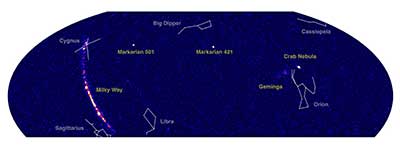By Gabriel Popkin

Image: HAWC
Sky map of high-energy gamma rays observed by HAWC. Many sources can be seen in the Milky Way and the extragalactic objects Markarian 421 and 501. Several well-known constellations are shown for reference.
APS April Meeting 2016 — Researchers with the High Altitude Water Cherenkov (HAWC) Gamma-Ray Observatory unveiled a new map of the very-high-energy sky on Monday, April 18 at the APS April Meeting 2016. The map includes data from the observatory’s first year of full operation, and includes 40 sources, 10 of which have never been seen before in gamma rays with energies above a few hundred GeV.
“It’s our deepest look at two-thirds of the sky,” said HAWC’s operations manager Brenda Dingus of the Los Alamos National Laboratory in New Mexico.
The observatory, which is located 4,100 meters above sea level near Mexico’s Volcán Sierra Negra, sees gamma rays from the entire Northern hemisphere, though Earth blocks its views of part of the Southern hemisphere. It measures some of the highest-energy photons any experiment has detected — those reaching energies between 100 GeV and 100 TeV. By contrast, visible photons have energies of around 1 eV, and most previous gamma-ray survey instruments, such as NASA’s Fermi Gamma-ray Space Telescope, are limited to photons in the hundreds of GeV range. The few other telescopes that can capture TeV photons see only a small patch of sky at a time and can observe only at night.
HAWC, by contrast, surveys two-thirds of the sky and observes 24 hours a day, giving it a uniquely broad view in both space and time. The observatory consists of an array of 300 7.3-meter-diameter tanks of purified water. It detects not gamma rays themselves, but showers of particles released when gamma rays hit molecules high in Earth’s atmosphere. Inside the tanks, the particles from these showers release Cherenkov radiation — faint light emitted when a charged particle travels faster than the speed of light in its medium — which is then picked up by photomultiplier tubes. “It doesn’t look like or work like any other observatory,” said Dingus.
The HAWC map includes some known gamma-ray sources such as certain galaxies, the Cygnus cluster, and various regions of the Milky Way disk. But even when a source is known, the observatory can provide new information. For example, HAWC data suggest that a region in the Milky Way where researchers previously identified a single nebula named TeV J1930+188 may contain two or even three distinct gamma ray sources.
HAWC also observed gamma rays from the galaxy Markarian 501 mysteriously brightening and dimming over the course of several days in April. “We don’t really know [where the] gamma rays are coming from,” said astrophysicist Robert Lauer of the University of New Mexico, but he added that HAWC’s nonstop coverage should enable him and his colleagues to better understand the process causing the variability.
Meanwhile, with help from telescopes in other parts of the electromagnetic spectrum, project leaders are piecing together the sources of the abovementioned 10 detections that did not appear in previous TeV gamma-ray searches. Likely candidates include distant supernovas, stellar winds driven by pulsars like the one inside the Crab Nebula and high-energy jets that shoot out from black holes as they eat nearby matter. But project leaders aren’t ruling out previously unknown objects.
Though it hasn’t broken the high-energy record yet, HAWC detected a power-packed 60-TeV gamma ray — a photon more than four times as energetic as any human-made particle — coming from the Crab Nebula, which is a supernova remnant and a known gamma-ray source. And new data will soon push that number even higher, said astrophysicist Michelle Hui of NASA’s Marshall Space Flight Center in Huntsville, Alabama. “More is coming.”
“This is our announcement that we work as advertised,” said Dingus. But she and her colleagues are already planning to increase HAWC’s size and sensitivity, to capture even more gamma rays at the high end of the observatory’s energy range. “We will see the highest-energy photon that has ever been seen,” Dingus promised.
“This is really a triumph for HAWC,” says Julie McEnery, project scientist for the Fermi telescope at NASA’s Goddard Space Flight Center in Greenbelt, Maryland, and chair-elect of the APS Division of Astrophysics. McEnery says the two telescopes with their different energy ranges will together provide a more complete picture of gamma-ray sources than either can on their own. “We’ll be able to combine Fermi data and HAWC data on every bright, energetic thing in the sky.”
Gabriel Popkin is a freelance writer based in Mount Rainier, Maryland.
©1995 - 2024, AMERICAN PHYSICAL SOCIETY
APS encourages the redistribution of the materials included in this newspaper provided that attribution to the source is noted and the materials are not truncated or changed.
Editor: David Voss
Contributing Correspondent: Alaina G. Levine
Art Director and Special Publications Manager: Kerry G. Johnson
Publication Designer and Production: Nancy Bennett-Karasik
May 2016 (Volume 25, Number 5)
Articles in this Issue

